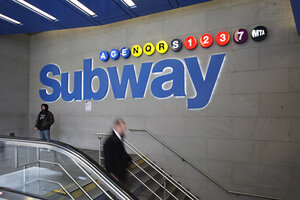Use public transportation. Save hundreds.
Even if it's not every day, riding the bus or train instead of driving a car will put money back into your wallet.

A man enters a New York City subway in New York's Times Square. The transportation system is operated by the Metropolitan Transportation Authority (MTA). Hamm argues that using public transport in lieu of your car could save you hundreds of dollars per month.
Mark Lennihan/AP
When I was in college – and for the first several months of my post-college career – I was an avid user of public transportation. I would ride the bus to work every day like clockwork.
For many semesters, I would catch a bus at about 7:48 AM or so. It deposited me right in front of one of the buildings where I would have a class at 8 AM at between 7:55 and 7:58 AM, giving me just enough time to stroll into the classroom, sit down, and open my notebook just as the professor began talking.
Later on, I would stand outside of that apartment building to catch the 7:37 AM bus, which would deposit me about two blocks from my work at about 7:55 AM or so, causing me to walk in the door about 8 AM. On days where I got an early start, I would catch the 7:07 AM bus (getting me there at 7:30) or even, on occasion, the 6:37 AM bus (getting me there at 7:00).
The best part was that the bus ride enabled me to do things like read a book or listen to NPR or an audiobook on my way to school or work. I did this virtually every morning and evening. I’d just carry a book in my bag and when I got to the bus stop, I’d pull out the book and start reading. When I got on the bus, I’d stick my finger in place just long enough to show the driver my pass, then I’d keep reading until it was time to pull the “stop” cord and get off at my destination.
On my way home, the bus stopped right by a grocery store, so I could stop there and pick up food. The bus ran roughly every fifteen minutes in the afternoon, so I would return to the bus stop and there’d be a bus along pretty quickly to get me if I made such a stop.
It was also far cheaper than driving myself to school/work. I paid about $79 for a six month bus pass that covered all rides, which is less than I would have paid just for the insurance on a car.
Time passed, though, and when I found myself making a good income, I convinced myself I needed a good car, too. I “bought” a truck (I no longer really think of it as “buying” something if you’re carrying a big debt on it) and, soon after, moved to an apartment outside of the range of the bus system.
Suddenly, I was free. I could go to work whenever I wanted! I could come home whenever I wanted! Freedom!
That freedom cost me about $250 a month in car payments, about $40 a month following the vehicle’s maintenance schedule, about $50 a month in gas, about $70 a month for auto insurance, and another $12 a month for parking.
$422 a month, down the tubes. Compare that to the $79 every six months I was paying for that bus pass.
Even if I just bought the vehicle and let it sit there, driving it rarely, I would still have about $335 a month in extra spending. In other words, it would have been cheaper to buy the vehicle, let it sit in the parking lot, and ride the bus to work than it would have been to drive the vehicle to work.
Unless you’re in a very unusual situation, where the cost of public transportation is really high or the price of gas and parking is really low, riding public transportation to work is going to be saving you money over driving to work.
That’s not to say that you must take public transportation every day. Ride it four days a week, then take your car the other day and do all of your lunchtime and after-work errands on the day you take your car. That way, you save money from the public transportation on the days when you’re just commuting, but have the flexibility of the automobile on the other days.
This post is part of a yearlong series called “365 Ways to Live Cheap (Revisited),” in which I’m revisiting the entries from my book “365 Ways to Live Cheap,” which is available at Amazon and at bookstores everywhere.

